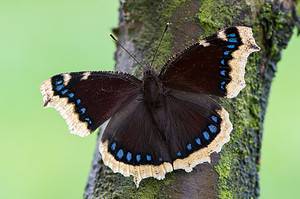Key Points:
- It’s thought that there are more than 17,500 butterfly types across the world, with some estimating up to 20,000 butterfly species.
- Butterflies are part of the Lepidoptera order of insects and can be classified as belonging to six families: Hesperiidae, Lycaenidae, Nymphalidae, Papilionidae, Pieridae, and Riodinidae.
- Some of the butterfly types on this list are the Brush-Footed Butterfly, American Snout, Blue Morpho, and Sleepy Orange.
Butterflies are beautiful creatures that typically have magnificent coloring and are associated with sunshine, flowers, transformation, hope, and freedom. They play important roles in the ecosystem as pollinators and food sources.
They can adapt to all sorts of habitats, from forests to Arctic tundra, and assist in maintaining an eco-friendly balance that helps environments thrive. Nearly one-third of the food we eat is dependent on pollination by creatures like butterflies.
In terms of pollination, butterflies tend to prefer taking care of herbs and vegetables, leaving fruit to their distant apian relatives. Examples of plants different types of butterflies pollinate include: artichokes, basil, beans, cabbages, cauliflower, celery, cilantro, and parsnips. These beautiful arthropods also pollinate cotton, a key crop.
How Many Types of Butterflies Are There?
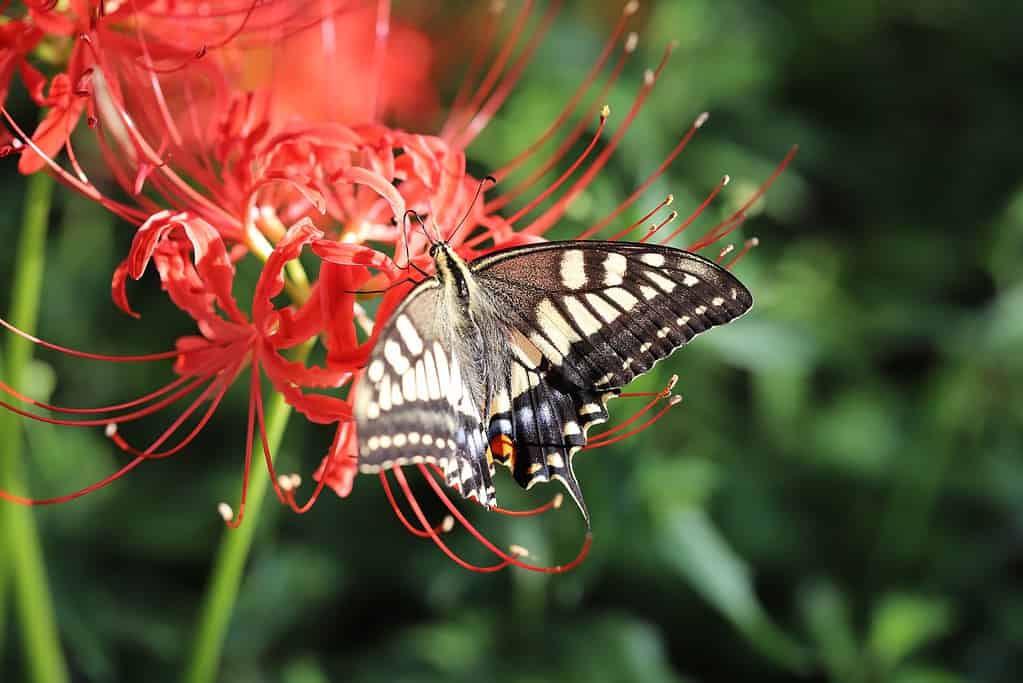
The swallowtail butterfly is found in more than 500 varieties all over the world except in Antarctica.
©Tasak/Shutterstock.com
It’s thought that there are more than 17,500 butterfly types across the world, with some estimating up to 20,000 butterfly species on Earth. In the United States, approximately 750 species of butterfly are present.
Butterflies belong to the Lepidoptera order of insects that also includes moths. Lepidoptera covers 180,000 species in 126 families, making it one of the world’s most widespread and recognizable insect orders.
Butterflies are part of the macrolepidopteran suborder clade Rhopalocera, which is categorized into the superfamilies of Hedyloidea (moth-butterflies found in the Americas) and Papilionoidea (remaining species).
While there is some debate about the classification of butterflies, they can be considered as comprising of the following six families:
- Hesperiidae: Including around 3,000 species in the world and called Skippers
- Lycaenidae: Covering more than 5,000 species, including Blues, Hairstreaks and Coppers
- Nymphalidae: With around 5,000 species, known as Brush-Footed Butterflies
- Papilionidae: Consisting of about 600 species, referred to as Swallowtails
- Pieridae: Encompassing more than 1,000 species, called Whites and Yellows/Sulphurs
- Riodinidae: Estimated to have approximately 1,000 species, with the common name of Metalmarks.
You can check out these families in more detail in our butterfly guide here.
Keep reading for a look at 10 of the most beautiful common butterflies.
10. Brush-Footed

The brush-footed butterfly has more than 6,000 species in its family.
©EmekKiziltas/Shutterstock.com
The brush-footed butterfly is also called the four-footed butterfly because this species only uses four legs for walking. (The other two legs curl.) They’re part of the Nymphalidae family. The brush-footed may be the biggest family of butterflies with more than 6,000 species.
These butterflies are named for their characteristically smaller forelegs that tend to appear fuzzy and resemble brushes. Not only do they have feet that look like brush, they also have a pair of antennas that come out of the tops of their heads.
This butterfly type generally is medium to large size and has a wing size between 1.5 and 3.5 inches. Wing colors are typically yellow, brown, and white with colored markings on the undersurface. Those colors tend to be duller.
One species, the peacock, native to Asia and Europe, has a unique identification for being the only recorded butterfly that actually makes a sound. Upon sensing a threat, the peacock butterfly will emit a hiss.
9. Monarch
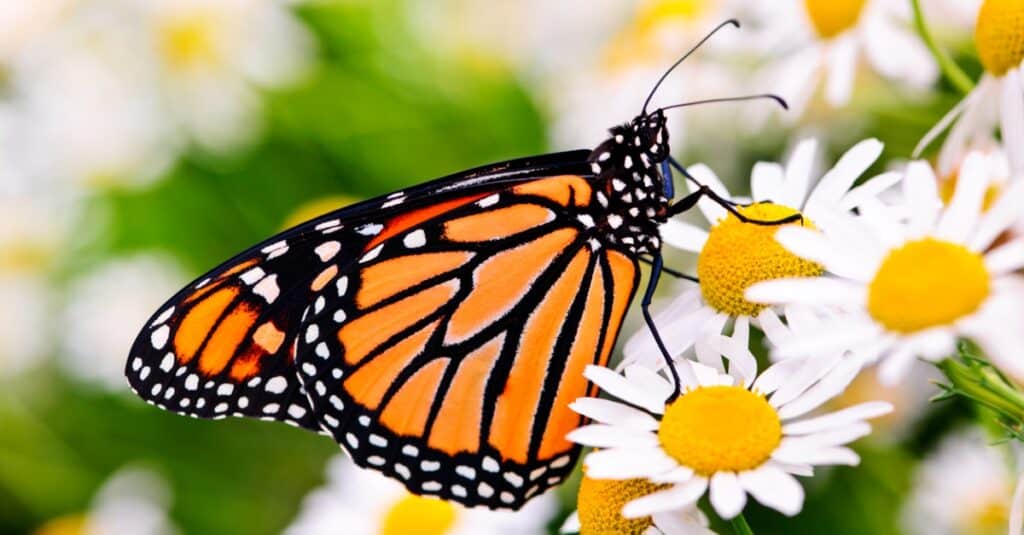
One of the most well-known types of butterfly, the monarch is recognized for its distinct color patterns.
©iStock.com/Elenathewise
A common butterfly, the monarch still manages to be one of the uniquely colored and beautiful among all butterflies. They’re easily recognized by an eye-catching combo of markings of white, orange, or black meshed with vibrant orange wings with white dots and black veins and borders.
Monarch butterflies call home sections of Central, North, and South America. You’ll also find them roaming regions of Western Europe, Australia, and India. Legend says that some European settlers in America were such fans of a particular monarch known as William of Orange (Prince of Orange from birth and then King William lll), that they named it in his honor. So monarch, meaning king, was given to the butterfly because of its primary shade.
This butterfly type’s wings will change color and shape with the migration process before turning a red hue with a greater elongated shape. Overall, monarch butterflies have four stages in their lifecycle: egg, larvae, pupa, and adult butterfly. The female produces a series of four generations a year.
8. Karner Blue
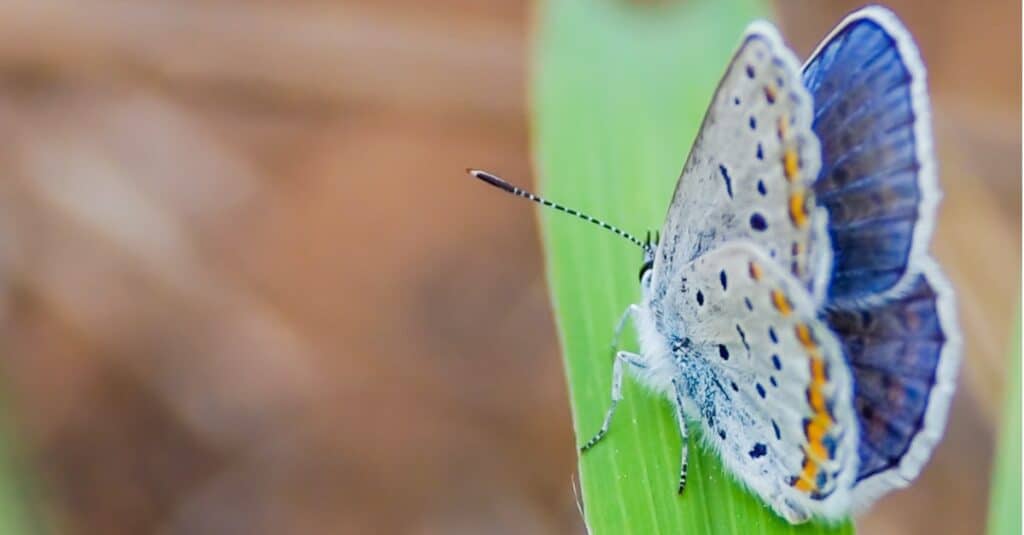
The Karner blue butterfly is abundant in Wisconsin and Michigan.
©iStock.com/BobGrif
Small and delicately beautiful is the Karner blue butterfly. Once upon a time, these types of butterflies boasted a huge population along Iupine’s northern edge, extending from eastern Minnesota to southern Maine. Today, the populace is in abundance in central and western Wisconsin and parts of Michigan.
Fairly tiny, the Karner blue has a wingspan of an average of 1 inch. The female has a smart display of grayish-brown with touches of topside blue, orange-colored bands with narrowed black borders. The males have either dark blue or silvery topsides matched up with narrow black margins.
This type of butterfly was labeled endangered in the early 1990s. The population declined due to human modifications that caused the loss of habitats. But the Karner blue managed to restabilize its position.
7. American Snout
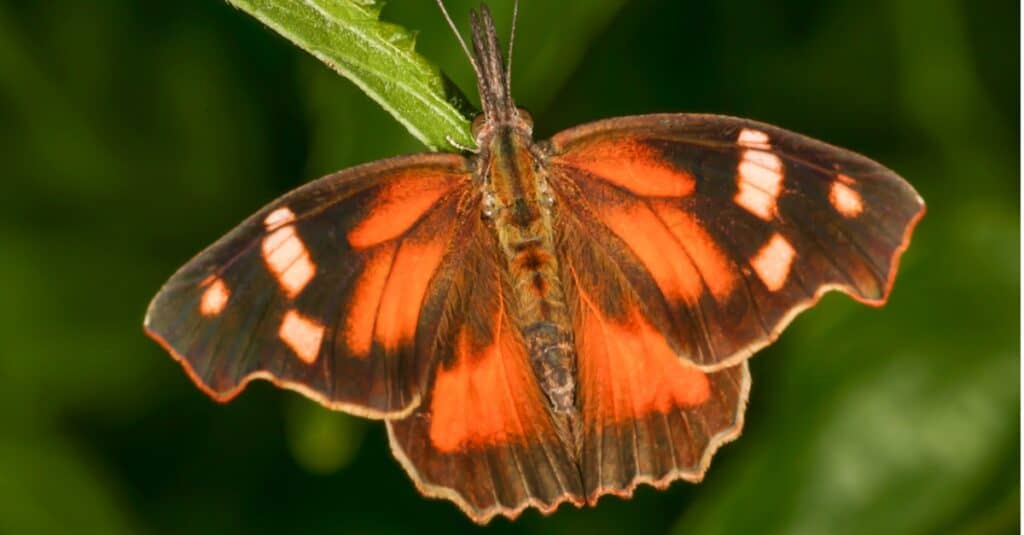
The American snout butterfly gets its name from its elaborate snout.
©iStock.com/EdwardSnow
The American snout is a member of the Libytheinae sub-family, which belongs to the Nymphalidae family — or the brush-footed butterfly class. The snout butterfly spends a lot of time in the North and South Americas.
The name is inspired by this type of butterfly having an elaborate snout. Lepidopterolists (people who study butterflies) believe those long snouts are a gift from Mother Nature that lets the insect mimic dry leaves. The insects use the feature to camouflage themselves to avoid predators.
Wingspans have a range of 1.4 to 2 inches. Besides being relatively small, these butterflies come in dull colors, which probably complements the snout’s ability to effectively camouflage the creatures. Upper wing surfaces are brownish-black with orange patches. The forewings have white spots. But the hind wing underside contrasts those subdued colors with beautiful purples and browns.
6. Blue Morpho
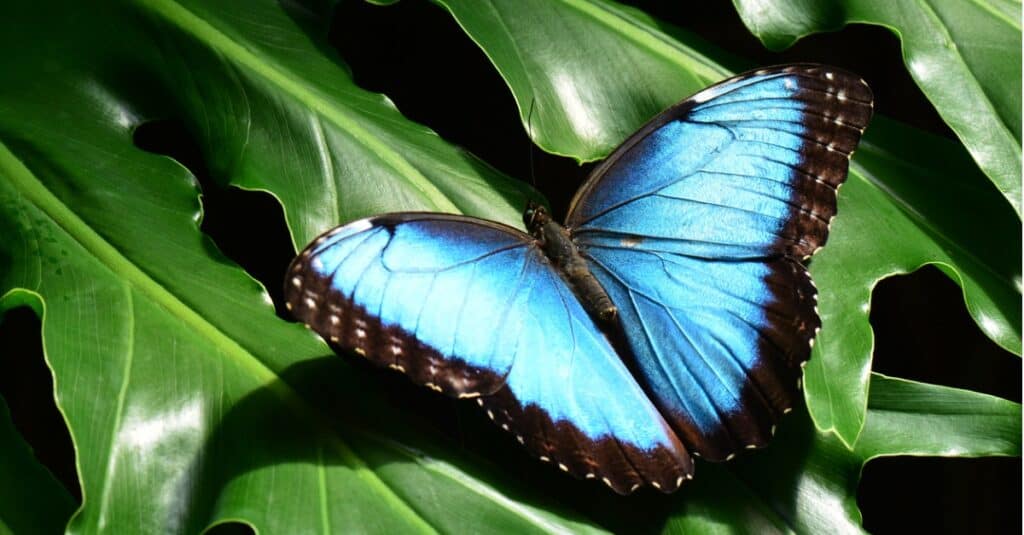
The morpho is one of the largest butterflies in the world and has a wingspan of 5-8 inches.
©iStock.com/SHAWSHANK61
Belonging to the tropical areas of Latin America, the blue morpho is a striking thing of beauty. With a lifespan of only 115 days, they live out their lives finding and eating desired fruit. Besides natural predators like the jacamar who diet on the morpho, facts are the blue morpho also suffers from collection by people and having their habitats decimated by encroachment by humans.
With a wing size of 5 to 8 inches, the morpho is one of the largest butterflies in the world. Its iridescent, vivid blue color consists of microscopic scales that reflect light off the wings. The underside of its wings is dull brown and, when closed, offers camouflage against birds, insects, and other predators. In-flight, the flapping blue and brown gives the illusion the morpho is disappearing and reappearing.
5. Sleepy Orange
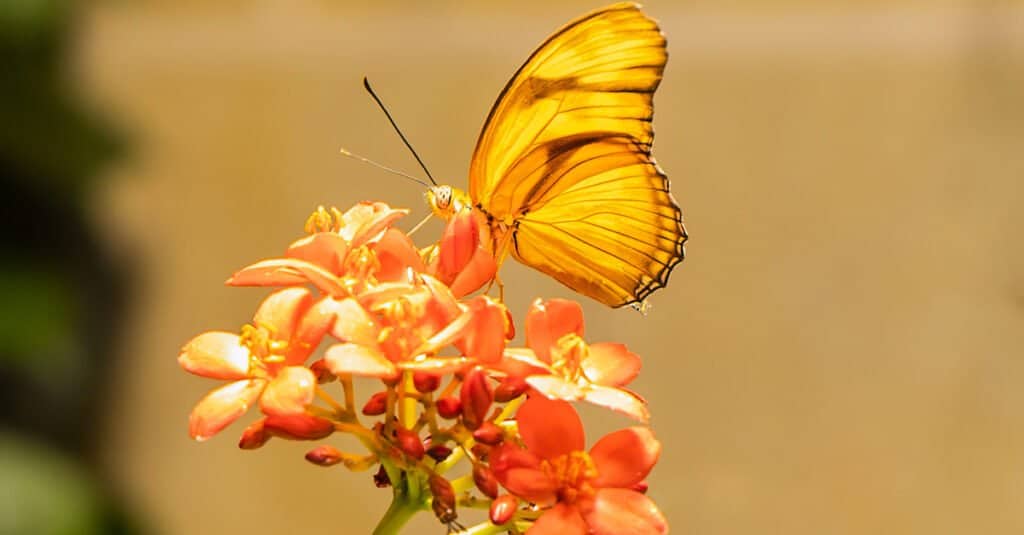
There is nothing sleepy about the sleepy orange, which is active year-round in Central America.
©iStock.com/Ami Parikh
A member of the sub-family Coliadinae of the Pieridae family, it’s no surprise the sleepy orange has a bright orange coloring, often with black borders across the wings’ upper sides. The underside colors vary based on the seasons. In summer, wings will be a sharp yellow with red highlights. In colder seasons, the wings keep a brown shade with comparatively heavier markings.
Interestingly, there’s nothing sleepy about these creatures. They’re quite busy, racing about as if they’re late for something. They can be wondrous to watch, injecting beauty and splendor wherever you find them. Some theorize the “sleepy” derives from the identification of black spots on the forewing looking like closed eyes.
These types of butterflies have a nice wing size of 1.4–2.24 inches. A tropical species, these animals are visible year-round in Central America and across the southern tier of North America.
4. Creamy Marblewing
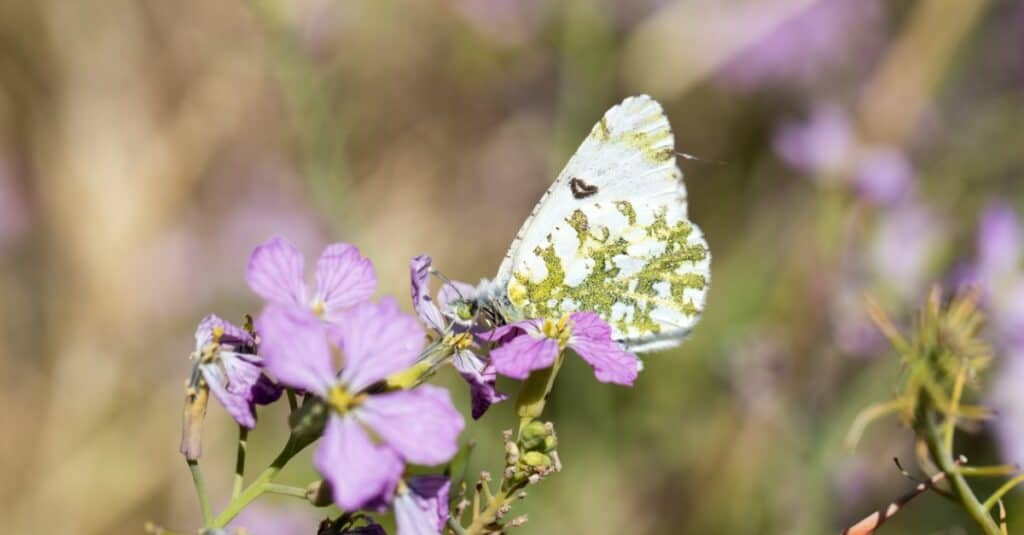
TThe creamy marblewing lays eggs on terminal flower buds that are typically a variety of the mustard family.
©iStock.com/yhelfman
The creamy marblewing butterfly population spans much of southern Alaska to northern New Mexico. In between, you’ll find these insects in California, Arizona, Minnesota, and Idaho. They like open, free-range fields and meadows. The insects also prefer moist habitats.
Considered a large creature, key identification traits and features are a head of furry scales with green and large, round eyes of the same green color. The underside of the wings is cream with a curious marble-like greenish hue. The top surface is creamy white with black markings along the tips and edges.
A member of the Pieridae family, the creamy marblewing lays eggs on terminal flower buds. These plants tend to a variety of the mustard family. The insect larvae feed on the flowers, buds, and fruits of the plants for their diet.
3. Small Copper
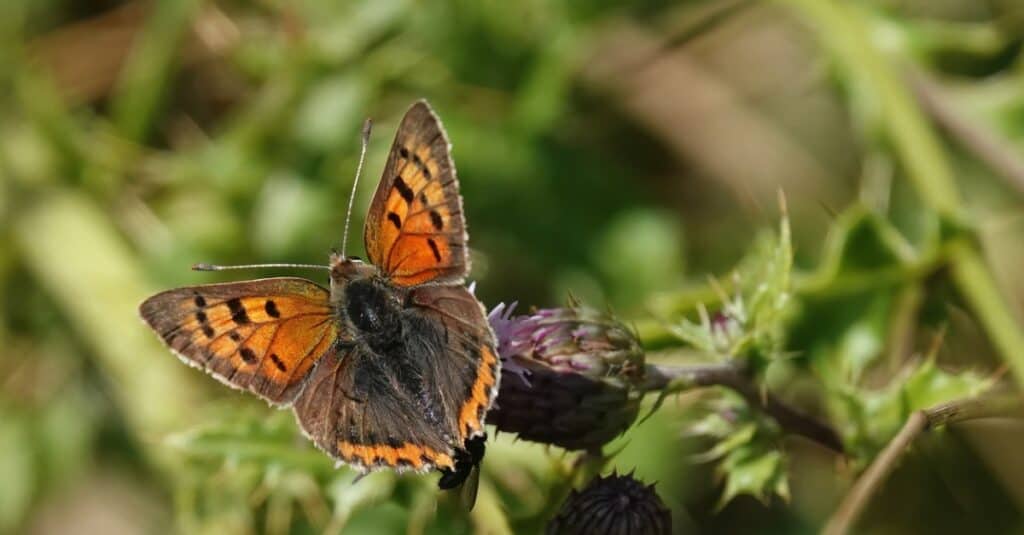
The small copper butterfly was once categorized as extinct in the U.K.
©iStock.com/Nigel Harris
Famous for its speed and vibrant forewings of copper color, this gorgeous species of butterfly is all over Britain and Ireland. The insects like sunny, dry habitats, including woodland edges, downland, and waste ground.
This type of butterfly holds a wingspan of 1.25 to 1.4 inches. The upper wing side is a shiny yellow with black blotches and dark brown margins. The underside of the wings is bright orange with more dark blotches and margins highlighted by reddish stripes. These features easily distinguish these coppers from cousin coppers. In gardens, the butterfly comes flying in for a diet of nectar-rich foods and, for overwintering, seek shrubs, and climbing ivy.
The large copper butterfly was categorized as extinct almost two centuries ago in the United Kingdom as the result of the English fenland draining. The species survived the labeling but remains listed as Near Threatened by the International Union for Conservation of Nature.
2. Red Admiral
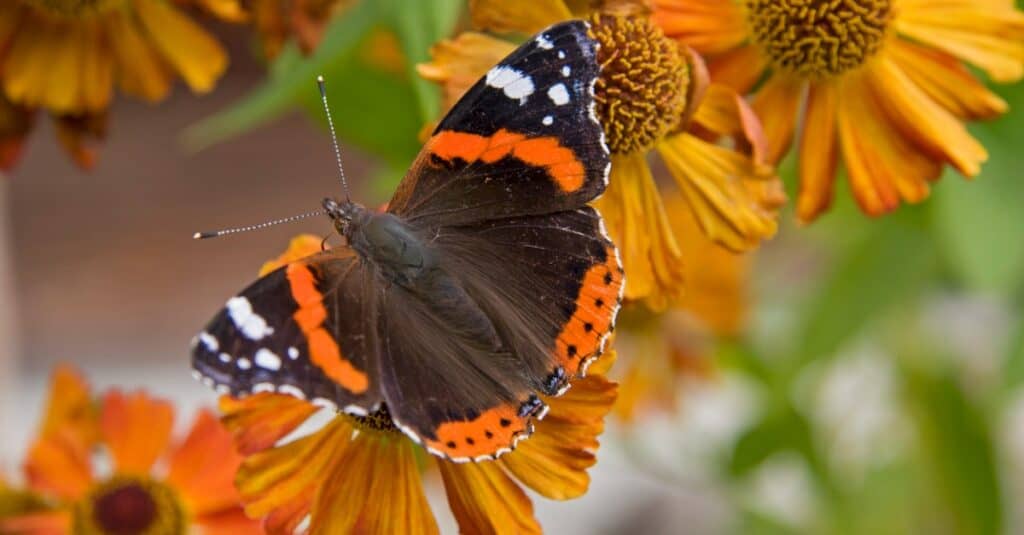
The red admiral is a type of butterfly that has a fairly large wingspan of nearly 3 inches.
©iStock.com/Tinieder
The red admiral is a distinctive butterfly found in Britain and Ireland. They belong to the Nymphalids family and are considered medium-sized creatures. They work with a wing size of 2.6 to 2.8 inches. They are famous for striking black wings with a blend of orange bands and white spots.
This type of butterfly flies freely in parks and gardens, marshes, moist fields and woods, and open fields. They also find comfort in habitats ranging from tundra to sub-tropic.
The red admiral is migratory. During the spring and autumn, they’ll head north. One of the many interesting facts about these insects is they’re extremely territorial. Females only mate with males that control their habitat. Males also settle on ridge tops and wait for the female. There, the female will lay eggs on plant leaves.
1. Swallowtail
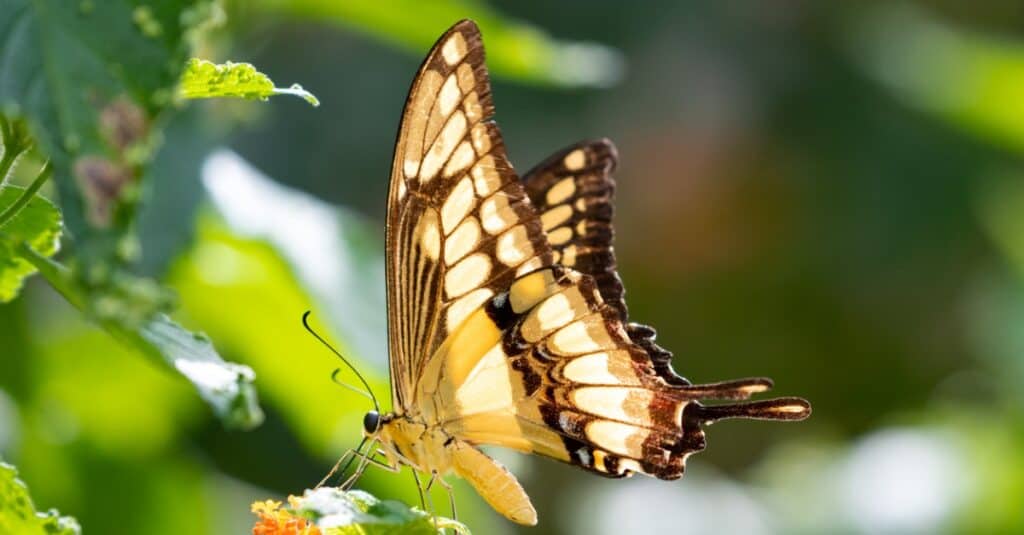
The swallowtail has 40 species that fly in North America.
©iStock.com/Chelsea Sampson
Large and colorful, the swallowtail butterfly comes in more than 500 varieties. The swallowtail as a type of butterfly has a bizarre wingspan of 0.3 to 3.5 inches. Belonging to the Papilionidae family, these creatures are found all over the world except in frigid Antarctica.
The greatest populace and diversity is in sub-tropical regions like East and Southeast Asia. A total of 40 species fly in North America. There’s an even dozen in Europe.
One of this butterfly’s interesting facts is the name came from the extensions in their hind wings. They are tail-like. But we should note some species don’t have the extensions. There’s a range of colors and the majority of species feed solely on milk parsley. Others prefer wild carrots.
Summary of 10 Types of Butterflies
Here’s a recap of the 10 commonly found types of butterflies we took a look at.
| Number | Butterfly Species |
|---|---|
| 1 | Swallowtail |
| 2 | Red Admiral |
| 3 | Small Copper |
| 4 | Creamy Marblewing |
| 5 | Sleepy Orange |
| 6 | Blue Morpho |
| 7 | American Snout |
| 8 | Karner Blue |
| 9 | Monarch |
| 10 | Brush-Footed |
The photo featured at the top of this post is © iStock.com/Chelsea Sampson
Thank you for reading! Have some feedback for us? Contact the AZ Animals editorial team.





